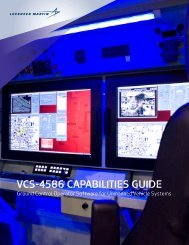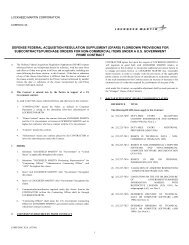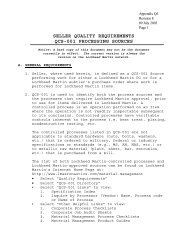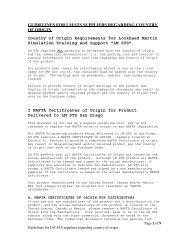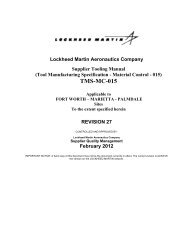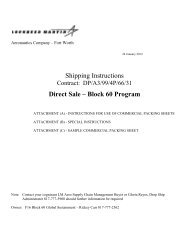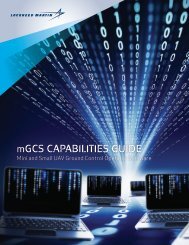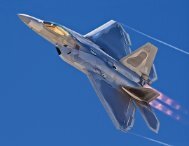National Air and Space Museum Scavenger Hunt - Lockheed Martin
National Air and Space Museum Scavenger Hunt - Lockheed Martin
National Air and Space Museum Scavenger Hunt - Lockheed Martin
- No tags were found...
You also want an ePaper? Increase the reach of your titles
YUMPU automatically turns print PDFs into web optimized ePapers that Google loves.
NATIONAL AIR &SPACE MUSEUM<strong>Lockheed</strong> <strong>Martin</strong><strong>Scavenger</strong> <strong>Hunt</strong>
LOCKHEED MARTIN SCAVENGER HUNTNATIONAL AIR AND SPACE MUSEUMAs part of our 100th anniversary commemoration, we’rehighlighting some of <strong>Lockheed</strong> <strong>Martin</strong>’s most notabletechnologies featured in The Smithsonian Institution’s<strong>National</strong> <strong>Air</strong> <strong>and</strong> <strong>Space</strong> <strong>Museum</strong> on the <strong>National</strong> Mall inWashington, D.C.We invite you, your family, <strong>and</strong> your friends to visit themuseum <strong>and</strong> explore the exhibits featured in this guide. You’llsee air <strong>and</strong> space innovations from our past, present, <strong>and</strong>future—from the aircraft that broke transcontinental speedrecords in the 1920s, to a space telescope that spots far-offgalaxies, <strong>and</strong> the GPS satellites that will improve navigationfor years to come.This is our legacy. Ours is a story built on principles ofimagination, innovation <strong>and</strong> integrity, <strong>and</strong> rich with purpose<strong>and</strong> performance. We hope you feel as inspired as we do duringthe course of your visit. And don’t forget as you look to theskies: Dream big!• Stardust was the firstU.S. mission dedicatedto exploring a comet<strong>and</strong> returning physicalsamples from a cometto Earth.• Stardust launched fromCape Canaveral <strong>Air</strong>Force Station, Fla., onFeb. 7, 1999.• On Jan. 2, 2004,Stardust came withinapproximately 149miles of a comet, took72 images of its surface,<strong>and</strong> gathered particlesfrom a cloud of dust<strong>and</strong> ice surrounding thecomet.• Stardust’s samplessuccessfully returned toEarth on Jan. 15, 2006.Cover photo - NASA: Orion Multi-Purpose Crew Vehicle. <strong>Lockheed</strong> <strong>Martin</strong> is the prime contractor toNASA for the Orion Multi-Purpose Crew Vehicle, the nation’s first interplanetary spacecraft designedto carry astronauts beyond low Earth orbit on long-duration, deep-space missions to destinations suchas asteroids, Lagrangian Points or the moon. When paired with additional propulsion <strong>and</strong> life supportsystems, Orion will eventually be able to take humans to Mars.Object images courtesy of the Smithsonian Institution.Scan with your mobiledevice to learn more.Stardust CapsuleNATIONAL AIR AND SPACE MUSEUMLOCKHEED MARTIN SCAVENGER HUNT
LOCKHEED MARTIN SCAVENGER HUNTNATIONAL AIR AND SPACE MUSEUMHubble Test Telescope• The Hubble <strong>Space</strong>Telescope is theworld’s premierorbiting astronomicalobservatory.• NASA selected<strong>Lockheed</strong> <strong>Martin</strong> todesign <strong>and</strong> constructthe Hubble in 1977.The telescopelaunched in 1990.• Global Positioning System (GPS) III is the nextgeneration of GPS navigation.• GPS III improves GPS system security, accuracy<strong>and</strong> reliability.• GPS III satellites are designed to operatefor 15 years, three years longer than theirpredecessors.• <strong>Lockheed</strong> <strong>Martin</strong> powered on the first GPS IIIsatellite in February, 2013.Scan with your mobiledevice to learn more.• Hubble has takennearly one millionimages <strong>and</strong> observedapproximately32,000 objects.Hint: Look up on the south wall of the exhibition tosee a graphic representation of the satellite.• Astronomers usingHubble data havepublished nearly8,500 scientificpapers.Scan with your mobiledevice to learn more.GPS IIINATIONAL AIR AND SPACE MUSEUMLOCKHEED MARTIN SCAVENGER HUNT
LOCKHEED MARTIN SCAVENGER HUNTNATIONAL AIR AND SPACE MUSEUMVega• Charles A. Lindbergh <strong>and</strong> his wife, Anne MorrowLindbergh, purchased this airplane in 1929 for$22,825.• The Lindberghs set a coast-to-coast speedrecord in the airplane on April 20, 1930, but itsmost significant flights were in 1931 <strong>and</strong> 1933.Scan with your mobiledevice to learn more.• In 1931 the Lindberghs flew to the Orient,proving the viability of traveling from the West to the Far East viathe Great Circle route to the North. In 1933 they flew survey flightsacross the North <strong>and</strong> South Atlantic to gather information forplanning commercial air routes.• During their 1933 trip a Greenl<strong>and</strong> Eskimo boy gave the aircraft itsnickname: “Tingmissartoq— one who flies like a big bird.”• Introduced in 1927, the Vega was the first productof designer Jack Northrop <strong>and</strong> Allan Loughead’s<strong>Lockheed</strong> <strong>Air</strong>craft Company.• The first Vega 1, named the Golden Eagle, flewfrom <strong>Lockheed</strong>’s Los Angeles plant on July 4,1927.• In 1928, Vega 5 Yankee Doodle was used to breaktranscontinental speed records.Scan with your mobiledevice to learn more.• On May 20–21, 1932, Amelia Earhart became the first woman tofly nonstop <strong>and</strong> solo across the Atlantic Ocean. She flew in this red<strong>Lockheed</strong> Vega 5B.• Earhart called this plane her “Little Red Bus.”TingmissartoqNATIONAL AIR AND SPACE MUSEUMLOCKHEED MARTIN SCAVENGER HUNT
LOCKHEED MARTIN SCAVENGER HUNTF-104 StarfighterNATIONAL AIR AND SPACE MUSEUM• By 1943, mounting combat losses of Americanstrategic bombers to German propeller-driveninterceptors encouraged the United States topush for a new, more capable combat jet.• <strong>Lockheed</strong> <strong>Air</strong>craft Corporation <strong>and</strong> Clarence“Kelly” Johnson were up to the challenge. Johnson<strong>and</strong> a team of designers began work on a prototype,designated the XP-80, on June 21, 1943.Scan with your mobiledevice to learn more.• To keep the work secret, Johnson walled off the production area withdiscarded engine crates <strong>and</strong> a circus tent.• On Jan. 8, 1944, the <strong>Lockheed</strong> chief test pilot, Milo Burcham, tookwhat became known as the “Lulu-Belle” into the sky for the first time.During this flight, Burcham reached an impressive speed of 880 kph(547 mph) while flying straight <strong>and</strong> level.• Known as “the missile with a man in it,” the stubbywinged<strong>Lockheed</strong> F-104 Starfighter was the firstU.S. jet fighter in service to fly Mach 2, twice thespeed of sound.• The F-104 was developed to compete againstSoviet MiGs in the early 1950s.• Designed as a high-performance day fighter, theF-104 had excellent acceleration <strong>and</strong> top speed. Itfirst flew on Feb. 7, 1954.Scan with your mobiledevice to learn more.• While built for the U.S. <strong>Air</strong> Force, most Starfighterswere flown by other countries, particularly Canada,Italy, Germany, <strong>and</strong> Japan.XP-80 “Lulu-Belle”NATIONAL AIR AND SPACE MUSEUMLOCKHEED MARTIN SCAVENGER HUNT
LOCKHEED MARTIN SCAVENGER HUNT<strong>Lockheed</strong> U-2BONUS• The Marauder was designed by the Glenn L.<strong>Martin</strong> Company in 1939, on the eve of WorldWar II.NATIONAL AIR AND SPACE MUSEUM• 5,266 Marauders were ultimately produced forthe war.• The Marauder flew in World War II’s Pacific,European, <strong>and</strong> North African theaters.Scan with your mobiledevice to learn more.• Originally known as the “Martian”, the Britishdubbed the aircraft the Marauder.BONUS• The U-2’s initial designs were created by <strong>Lockheed</strong><strong>Martin</strong>’s Skunk Works® founder Clarence “Kelly”Johnson in 1953.• The U-2 can fly missions of up to 3,000 miles,carry 700 pounds of payload, <strong>and</strong> cruise at 70,000feet.• Beginning in the summer of 1956, U-2s flew deepinto the heart of the Soviet Union, capturingdetailed photos of airfields <strong>and</strong> factories.Scan with your mobiledevice to learn more.• The “Dragon Lady” is still in civil <strong>and</strong> military servicetoday.B-26 MarauderNATIONAL AIR AND SPACE MUSEUMLOCKHEED MARTIN SCAVENGER HUNT
Map of the <strong>Museum</strong>SECOND FLOOR211 210 209 208 207 206 205213LOCKHEEDMARTINIMAXTHEATERALBERTEINSTEINPLANETARIUM203PublicObservationProjectWright PlaceFood Court111112FIRST FLOORIndependence Avenue Entrance110 109 108 107 106 105104113114LOCKHEEDMARTINIMAXTHEATER100102Mall EntranceWelcome CenterWheelchairsWright Place Food Court<strong>Museum</strong> StoreSimulatorsExhibit Locations:Stardust CapsuleGallery 100(Milestones ofFlight)Hubble TestTelescopeGallery 114(<strong>Space</strong> Race)GPS IIIGallery 213(Time <strong>and</strong>Navigation)Tingmissartoq<strong>and</strong> VegaGallery 208(Pioneers of Flight)F-104StarfighterNearPlanetarium onSecond FloorXP-80“Lulu-Belle”Gallery 106(Jet Aviation)<strong>Lockheed</strong> U-2Gallery 110(Looking atEarth)B-26 MarauderGallery 205(World War II)http://www.lockheedmartin.com/us/100years.html




